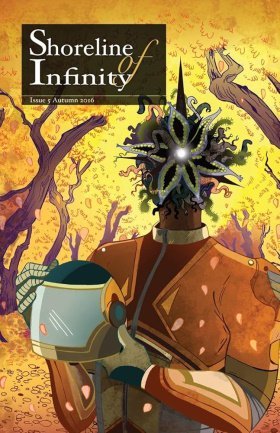I supposed there wasn’t. Slowly, reluctantly, we stood—and saw standing not more than twenty metres away …
“What the ..?” I managed.
“Original.” remarked Melano; the other Melano. Two familiar figures stood in the central avenue, each holding a sleek, black pistol casually in a sleek, black hand. Their manufactured bodies were identical in their muscular outlines, but the faces left no doubt.
“Who the fuck are you?” asked Melano; my Melano.
“Now that is an obvious question.” the other figure sighed. “Quite uninteresting, in fact. We’re you, of course.”
“But—” Melano’s twin hushed her with a wave of her gun.
“Manners, now.”
Melano and I looked at each other. At ourselves. At each other.
“Where the fuck is Tjssin?” we both asked in unison.
“Ah. Tjssin …” my doppelgänger began, “Our most ignoble and ignorant tormentor. If he could have seen the fine mess his little joke would land us in, perhaps even he would have thought twice before boosting out of Aurelia.” I—she—smiled wistfully.
“Tjssin was never here,” she went on. “He faked us out. Probably turned back to Auriela within the first light year. He faked us and we fell for it. Fell all the way to this arse-fucked, dead-end, nameless system. He never came within a dozen light years of this shit hole.”
My head was spinning. I saw myself from outside myself; saw the expression of bewilderment pasted across my own face.
“Then…” I began.
“Go on.” the other Melano urged.
“Then the resonance—it wasn’t him. It’s you.”
“Congratulations. Though more accurately, it’s you.”
“You feel it; both of you?” said the other Melano. “It’s strong now, and it will only get stronger.”
“The resonances build with every duplication.” my double explained. “It’s bad enough now, but wait till there are twenty, fifty, a thousand of us.” she—I—looked visibly horrified at the thought.
“Wh—what exactly are you saying?’.
My double smiled apologetically. “You are aware of the anomaly that occurred shortly after the braking manoeuvre around the outermost planet?” she went on.
I nodded.
“Our best guess is that we suffered a close encounter with a high mass, high velocity object passing through the system: a wayward black hole or some other chunk of equally implausible degenerate matter, on its merry way from nowhere to nowhere. Such things exist—so they say,” my doppelgänger shrugged.
I saw the pieces falling into place; realised I had already seen them, over and over. Whatever the final cause of the anomaly, its effect was clear: the seed swarm must have been ripped apart; slung out to every corner of the system, its component parts half corrupted, unable to communicate with each other. The nanoware was purposely designed to withstand extremely high rates of attrition, so only a handful of spores need survive the transit intact in order to accomplish their purpose.
A handful had.
“This isn’t supposed to happen.”
“Clearly. It’s unprecedented, but not entirely unexpected. If history has taught us anything, it’s that given enough time and space, everything that possibly can go wrong will go wrong.”
I looked hard into my own eyes, searching for some glimmer of empathy. I found none.
“Sorry,” Melano’s other offered, “shit happens.”
I found no words. There was nothing I could say that would make any difference.
Melano finally spoke for me; asked the question I already knew the answer to.
“What is this place?” she said.
“Take a look,” her double suggested, gesturing to the monolith between us.
The structure, like everything else, was made of solid diamond, inlaid with the same recursive graphite patterning. Behind the smoky arabesques lurked a dark shape. A small patch of unencrusted diamond beckoned on the top surface. I leant closer, but I already knew:
There, encased beneath the jewelled glass, lay the hollowed mask of my own face.
This place was our tomb.
“We’re this side,” my double said, “Melano the other. We tried alternating caskets, but finally this seemed the most elegant solution. Rather beautiful, really, isn’t it? Peaceful.”
“How many?” I croaked, my mouth dry.
“Sorry.” Melano cut in, “We’d love to stand here and chat all day, really, but you’d be amazed how quickly it gets old explaining the same fucking thing over and over.”
“She’s right,” my double admitted.
My mind reeled at the unfurling immensity of the tableau before us; the tableau which was us—

























